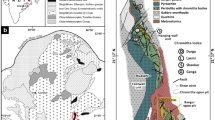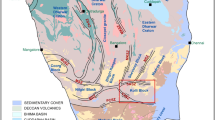Abstract
The zeolites and coexisting minerals of the silicic vitric tuffs in the Alaçatı (Çeşme) area, west of İzmir (Turkey), were studied. Mordenite is the most abundant zeolite in tuffs of the Alaçatı area and usually coexists with clinoptilolite-heulandite, smectite and calcite. Opal-CT was identified by means of its crystal morphology and EDX spectrum. Scanning electron microscopy (SEM) revealed the relative age relationships between the zeolites and coexisting minerals, namely mordenite, clinoptilolite-heulandite, smectite, calcite, and, in addition, opal-CT. Smectite consistently crystallized earlier than any of the zeolites, and it occasionally coats the outer walls of some of the vitric material. The zeolites are commonly located on the smectite, although some mordenites were observed to be in direct contact with glass shards that lacked a smectite coating. Clinoptilolite-heulandite formed after smectite and before mordenite. Opal-CT is seen to postdate both smectite and needle-shaped mordenite. Calcite was probably the latest mineral to crystallize in the Alaçatı tuffs. The zeolites in the tuffs of the Alaçatı area formed by dissolution of silicic vitric tuffs by Na- and Ca-rich thermal waters which passed through the fracture zone. The appearance of zeolites together with smectite along this zone may be attributed to a semi-open system which subdivided into smaller closed systems. Small changes in the pH and chemical composition of the thermal waters during alteration produced the corrosion effects observed by SEM. Small amounts of clinoptilolite-heulandite were corroded prior to crystallization of coexisting mordenite. The different compositions of the thermal waters were probably inherited from water that resulted from mixing of thermal and groundwaters.
Similar content being viewed by others
References
Bowers, T.S. and Burns, R.G. (1990) Activity diagrams for clinoptilolite: Susceptibility of this zeolite to further diagenetic reactions. American Mineralogist, 75, 601–619.
Brathwaite, R.L. (2003) Geological and mineralogical characterization of zeolites in lacustrine tuffs, Ngakuru, Taupo Vocanic Zone, New Zealand. Clays and Clay Minerals, 51, 589–598.
Caballero, E., Reyes, E., Huertas, F., Linares, J. and Pozzuoli, A. (1991) Early-stage smectites from pyroclastic rocks of Almería (Spain). Chemical Geology. 89, 353–358.
Cocheme, J.-J., Leggo, P.J., Damian, G., Fulop, A., Ledesert, B. and Grauby, O. (2003) The mineralogy and distribution of zeolitic tuffs in the Maramures Basin, Romania. Clays and Clay Minerals, 51, 599–608.
Christidis, G.E. (2001) Formation and growth of smectites in bentonites: a case study from Kimolos Island, Aegean, Greece. Clays and Clay Minerals, 49, 204–215.
Erdogan, B., Altıner, D., Güngör, T. and Özer, S. (1990) Karaburun Yanmadasının Stratigrafisi, MTA Dergisi. No: 111, 1–22, Ankara (in Turkish).
Esenli, F. (1993) The chemical changes during zeolitization (Heulandite-Clinoptilolite type) of the acidic tuffs in the Gördes Neogene Basin. Geological Bulletin of Turkey, 6, 37–44.
Fragoulis, D., Chaniotakis, E. and Stamatakis, M.G. (1997) Zeolitic tuffs of Kimolos island, Aegean Sea, Greece and their industrial potential. Cement and Concrete Research. Vol. 27, No. 6, pp. 889–905.
Fuente, S., Cuadros, F. and Linares, J. (2002) Early stages of volcanic tuff alteration in hydrothermal experiments: formation of mixed-layer illite-smectite. Clays and Clay Minerals, 50, 578–590.
Ghiara, M.R., Petti, C., Franco, E., Lonis, R., Luxoro, S. and Gnazzo, L. (1999) Occurrence of clinoptilolite and mordenite in Tertiary calc-alkaline pyroclastites from Sardinia (Italy). Clays and Clay Minerals, 47, 319–328.
Gemici, Ü. (1999) Çeşme yanmadasının hidrojeolojisi ve jeotermal enerji olanakları. PhD thesis, Dokuz Eylül Üniversitesi, Fen Bilimleri Enstitüsü, (in Turkish).
Gemici, Ü. and Filiz, S. (2001) Hydrochemistry of Çeşme geothermal area in western Turkey. Journal of Volcanology and Geothermal Research, 110, 171–187.
Gottardi, G. and Galli, E. (1985) Natural Zeolites. Springer-Verlag, Berlin, 409 pp.
Günay, G. and Şimşek, Ş. (1997) International Course on Geothermal District Heating Schemes, 20–26 October, Çeşme, İzmir, Turkey (in Turkish, unpublished).
Gündoğdu, M.N., Bonnot-Coutois, C. and Clauer, N. (1989) Isotopic and chemical signatures of sedimentary smectite and diagenetic clinoptilolite of lacustrine Neogene basin near Bigadic, Western Turkey. Applied Geochemistry, 4, 635–644.
Hawkins, D.B., Sheppard, R.A. and Gude, A.J. 3rd (1978) Hydrothermal synthesis of clinoptilolite and comments on the assemblage phillipsite-clinoptilolite-mordenite. Pp 337–343 in: Natural Zeolites, Occurrence, Properties, Use (L.B. Sand and F.A. Mumpton, editors). Pergamon Press, New York, USA.
Hay, R.L. (1966) Zeolites and zeolites reactions in sedimentary rocks. Geological Society of America, Special Paper, 85, p. 130.
Hay, R.L. (1978) Geologic occurrence of zeolites, Pp. 135–143 in: Natural Zeolites, Occurrence, Properties, Use (L.B. Sand and F.A. Mumpton, editors). Pergamon Press, New York, USA.
Hay, R.L. and Guldman, S.G. (1987) Diagenetic alteration of silicic ash in Searles Lake, California. Clays and Clay Minerals, 35, 449–457.
Hay, R.L. and Sheppard, R.A. (1977) Zeolite in open hydrologic systems. Pp. 93–102 in: Mineralogy and Geology of Natural Zeolites (F.A. Mumpton, editor). Reviews in Mineralogy, 4. Mineralogical Society of America, Washington, D.C.
Helvacı, C. (1995) Stratigraphy, mineralogy and genesis of the Bigadiç borate deposits, Western Turkey. Economic Geology, 90, 1237–1260.
Honda, S. and Muffler, L.J.P. (1970) Hydrothermal alteration in core from research drill hole Y-1, upper Geyser Basin, Yellowstone National Park, Wyoming. American Mineralogist, 55, 1714–1737.
Iijima, A. (1974) Clay and zeolitic alteration zones surrounding Kuroko deposits in the Hokuroku District, northern Akita, as submarine hydrothermal-diagenetic alteration products. Mining Geology (special issue), 6, 267–289.
Kaçmaz, H. (2001) Alaçatı (Çeşme) tüflerinin jeokimyasal özellikleri ve zeolitleşme. M.Sc. thesis, Dokuz Eylül Üniversitesi, Fen Bilimleri Enstitüsü, Turkey (in Turkish).
Kaçmaz, H. and Köktürk, U. (2004) Geochemistry and mineralogy of zeolitic tuffs from Alaçatı (Çeşme) area, Turkey. Clays and Clay Minerals, 52, 705–713.
Kalogeropoulos, S.I. and Mitropoulos, P. (1983) Geochemistry of barites from Milos Island (Aegean Sea), Greece. Neues Jahrbuch für Mineralogie Monatshefte, 12, 13–21.
Kitsopoulos, K.P. (1997) The genesis of a mordenite deposit by hydrothermal alteration of pyroclastics on Polyegos Island, Greece. Clays and Clay Minerals, 45, 632–648.
Kristmannsdottir, H. and Tomasson, J. (1978) Zeolite zones in geothermal areas of Iceland. Pp. 277–284 in: Natural Zeolite Occurrence, Properties and Use (L.B. Sand and F.M. Mumpton, editors). Pergamon Press, Oxford, UK.
Kusakabe, H., Minato, H., Utada, M. and Yamanaka, T. (1981) Phase relations of clinoptilolite, mordenite, analcime and albite with increasing pH, sodium ion concentration and temperature. Scientific papers of the College of General Education, University of Tokyo, 31, 39–59.
Leggo, P.J., Cochemé, J.-J., Demant, A. and Lee, W.T. (2001) The role of argillic alteration in the zeolitization of the volcanic glass. Mineralogical Magazine, 65, 653–663.
Ma, C., Browne, P.R.L. and Harvey, C.C. (1995) Clay mineralogy of sedimentary rocks in the Wairakei geothermal system. Pp. 399–404 in: Clays: Controlling the Environment (G.J. Churchman, R.W. Fitzpatrick and R.A. Eggleton, editors). Proceedings of the 10th International Clay Conference, Adelaide, Australia, 1993, CSIRO Publishing, Melbourne, Australia.
Mas, G.R., Bengochea, L. and Mas, L.C. (2000) Hydrothermal alteration at El Humazo Geothermal area, Domuyo Volcano, Argentina. Proceedings of the World Geothermal Congress, Kyushu, Tohoku, Japan, 1413–1418.
Pe-Piper, G. (2000) Mode of occurrence, chemical variation and genesis of mordenite and associated zeolites from the Morden area, Nova Scotia, Canada. The Canadian Mineralogist, 38, 1215–1232.
Pe-Piper, G. and Tsolis-Katagas, P. (1991) K-rich mordenite from late Miocene rhyolitic tuffs, island of Samos, Greece. Clays and Clay Minerals, 39, 239–247.
Sheppard, R.A., Gude, A.J. III and Fitzpatrick, J.J. (1988) Distribution, characterization, and genesis of mordenite in Miocene Silicic Tuffs at Yucca Mountain, Nye County, Nevada. US Geological Survey Bulletin, 1777, 22 p.
Tomita, K., Yamane, H. and Kawano, M. (1993) Synthesis of smectite from volcanic glass at low temperature. Clays and Clay Minerals, 41, 655–661.
Welton, J.E. (1984) SEM Petrology Atlas. American Association of Petroleum Geologists, Tulsa, Oklahoma, USA.
Yalçın, H. (1988) Kırka (Eskişehir) yöresi volkano-sedimentar oluşumumlarının mineralojik-petrografik ve jeokimyasal incelenmesi. PhD thesis, Hacettepe Universitesi, Ankara, 209 pp. (in Turkish).
Yalçın, H. and Gündoğdu, M.N. (1987) Neojen yaşlı Emet gölsel volkanosedimenter baseninin mineralojik-petrografik incelenmesi. Neoformasyon minerallerinin oluşumu ve Dağılımı Yerbilimleri, 14, 45–61 (in Turkish).
Yalçın, H., Karayiğit, A.I., Cicioğlu, E. and Gümüşer, G. (1997) Relationship between clay mineralogy and whole-rock geochemistry of Sorgun (Yozgat) Eocene Coal Basin, Central Anatolia, Turkey. Pp. 15–24 in: Proceedings of the 8th National Clay Symposium, Kütahya, Turkey.
Yılmazer, S. and Yakabagı, A. (1995) Çeşme FY-1 kuyusu, kuyu bitirme raporu, No 9955. MTA, Ankara (in Turkish).
Author information
Authors and Affiliations
Corresponding author
Rights and permissions
About this article
Cite this article
Kaçmaz, H., Köktürk, U. Zeolites and coexisting authigenic minerals in Miocene tuffs of the Alaçatı (Çeşme) area, Turkey. Clays Clay Miner. 54, 587–597 (2006). https://doi.org/10.1346/CCMN.2006.0540505
Received:
Revised:
Published:
Issue Date:
DOI: https://doi.org/10.1346/CCMN.2006.0540505




